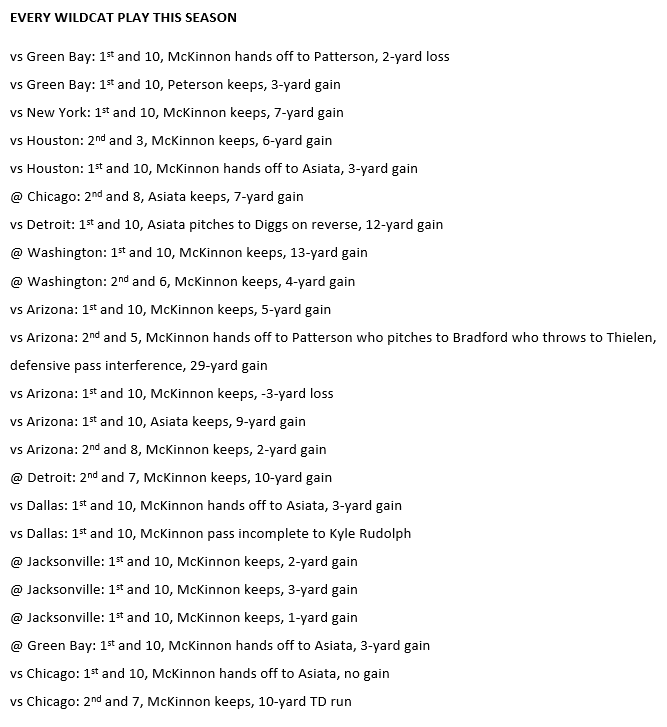Post by Funkytown on Apr 23, 2017 17:22:16 GMT -6
FOLLOW-UP: I Watched Every Vikings Wildcat Snap By Sam Ekstrom
...
...
Plenty more at the link (videos and analysis): zonecoverage.com/2017/vikings/follow-up-i-watched-every-vikings-wildcat-snap/
Back in November, following a Week 11 Minnesota Vikings win over the Arizona Cardinals, I laid out in this space the rationale behind why the Vikings’ Wildcat formation was working and what type of results it was producing.
To jog your memory, the Vikings were generating 5.2 yards per carry using the Wildcat through their first 10 games, and if you included a pass interference penalty on a Wildcat pass in the Arizona game, the per play average got bumped up to 6.8 — a robust average
To jog your memory, the Vikings were generating 5.2 yards per carry using the Wildcat through their first 10 games, and if you included a pass interference penalty on a Wildcat pass in the Arizona game, the per play average got bumped up to 6.8 — a robust average
While the Wildcat, as a whole, was successful relative to the team’s traditional run game, its usefulness slowed over the team’s final five games, bringing into question how frequently the Vikings will utilize it moving forward.
The final tally on the number of Wildcat attempts was 23, which the Vikings turned into 127 yards, or 5.5 yards per play.

The final tally on the number of Wildcat attempts was 23, which the Vikings turned into 127 yards, or 5.5 yards per play.

Clearly, the bottom line is positive. The Vikings were a league-worst rushing team yet were able to find a wrinkle that delivered results above the league average. That being said, teams may have begun to catch on in the final third of the season; either that, or the Vikings devised less creative looks. From Week 13 on, the Vikings only generated one above-average play with the Wildcat — a Week 17 touchdown run from McKinnon.
The remaining attempts over that stretch created the following gains: 3, 0, 2, 3, 1, 3, 0.
The only detectable difference between Good Wildcat and Bad Wildcat might be the absence of Cordarrelle Patterson in many of the plays. While the Vikings weren’t 100 percent on Wildcat plays when Patterson was in the backfield, he was a critical diversion in a number of the most success attempts, freezing defenders for a split second to free up McKinnon.
The remaining attempts over that stretch created the following gains: 3, 0, 2, 3, 1, 3, 0.
The only detectable difference between Good Wildcat and Bad Wildcat might be the absence of Cordarrelle Patterson in many of the plays. While the Vikings weren’t 100 percent on Wildcat plays when Patterson was in the backfield, he was a critical diversion in a number of the most success attempts, freezing defenders for a split second to free up McKinnon.
Plenty more at the link (videos and analysis): zonecoverage.com/2017/vikings/follow-up-i-watched-every-vikings-wildcat-snap/























 ... and neither is this Chris guy.
... and neither is this Chris guy.